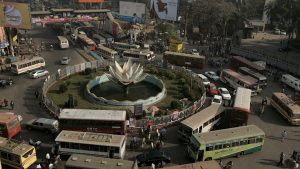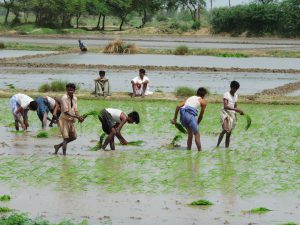“We were in a festive mood just after the celebrations for the Bengali new year. All preparations were made to harvest our crops but the sudden heavy rainfall and flash flood destroyed everything,” says Shafikul Islam, a farmer from Tahirpur Sadar in Sunamganj district, north-eastern Bangladesh. “The flood from Meghalaya (in India) submerged our farmlands, breaking the embankments. We lost everything.”
Islam’s lament is depressingly familiar in the bowl-shaped wetlands – called haors – in north-eastern Bangladesh, where thousands of farmers like him lose their crops to severe flooding whenever it rains heavily in the southern reaches of Meghalaya. Known as the wettest region of India, Meghalaya (“abode of clouds” in Sanskrit) receives, on average, 120cm of rainfall per year. Whenever it rains there, people living around the haors in Bangladesh are apprehensive.
But this year’s flash flood was different says Istiak Sobhan, environmental specialist at the World Bank in Bangladesh. Usually the region experiences flash floods in mid-May when farmers have already harvested their spring crops, he told thethirdpole.net but this year the region was submerged by a sudden flash flood in April, destroying the harvest.

Crops destroyed
Although the damage in Meghalaya was not very high, the loss to haor farmers in Bangladesh has been extensive. In Netrokona district alone, around 73,070 hectares of paddy fields were submerged, according to the Dhaka Tribune. “This paddy would have produced at least 281,320 tonnes of rice, the current market value of which is nearly BDT 956.49 crore (US$ 1.2 million),” Bilash Chandra Pal, the Netrokona district agricultural officer, told the newspaper.
The early flash flood also destroyed the spring Boro rice crop in more than 200,000 hectares of haor land in the Sunamganj, Sylhet, Moulvibazar, Netrokona and Kishoreganj districts.
Boro is the major paddy crop in Bangladesh, accounting for 19 of 34 million tonnes of annual production in the country, according to the Department of Agriculture Extension. The damage to two million tonnes of rice will cause the country to suffer for the rest of the year, and its impact has already been noticed following a hike in the prices of staple foods in the market, says agricultural economist, Quazi Shahabuddin.
The Bangladesh government is planning to buy 600,000 tons of rice from international markets, including India and Thailand. “We have already sought international tender to procure 100,000 tons of rice, even though we have not procured rice from international market for the last six years,” says Mohammad Badrul Hasan, director general of Bangladesh’s Department of Food.
Rotting rice
In addition to the loss of a good harvest, farmers and fishermen in the affected region complained of fish dying due to water contamination. At least 300,000 farmers were severely affected, which also created an acute shortage of fodder, forcing distress sales of farm animals.

Aziz Mia, a duck farmer who lives in Bishwambarpur, told thethirdpole.net that he had never seen such a flood in his life. He lost all 150 of his ducks and is now thinking of migrating to Sylhet city (Jalalabad) to look for work.
Towards the end of March, the rainfall in Sylhet, which is south of Meghalaya and across the border, was four times more than in the same days last year, according to the Bangladesh Meteorological Department. Rainfall was above normal from March 1 to May 10 this year in the north-east region of India, according to India Meteorological Department.
Role of climate change
Although the role of climate change in flash floods such as these is yet to be firmly established, pre-monsoon rainfall and its intensity may increase in the future, according to a recent study by the Bangladesh University of Engineering and Technology (BUET).
There is a need to prepare for the erratic monsoon rainfall, says AKM Saiful Islam, professor at the university’s Institute of Water and Flood Management and lead author of the study. But the annual damage to the haor region cannot be tackled by Bangladesh alone.
Syeda Rizwana Hassan, chief executive of the Bangladesh Environmental Lawyers’ Association, said at a recent media briefing that given the warm relations between the two countries, both governments should exchange information on potential floods.
![<p>The flash flood in April submerged the entire region and destroyed the harvest. The photo was taken in Tanaguar Haor in Sunamganj, Bangladesh, bordering Meghalaya, India [image by: Imtiaz Ahmed]</p>](https://dialogue.earth/content/uploads/2017/06/2.-Tanguar-Haor.jpg)







